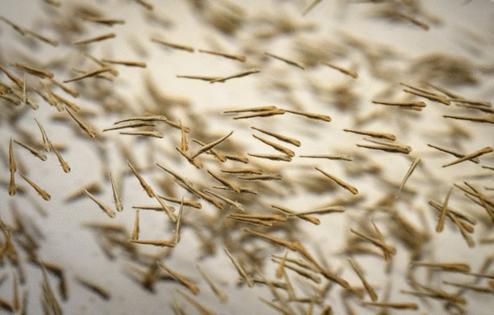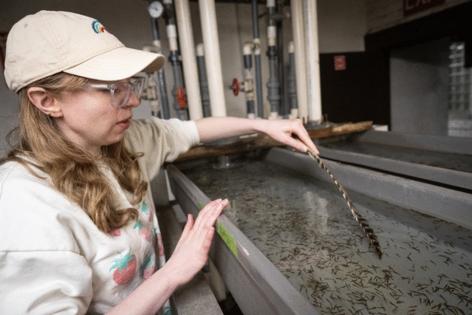Minnesota's 'Queen of Walleye' raises millions of fish in a DNR basement
Published in Outdoors
MINNEAPOLIS — Genevieve Furtner took a glob of hundreds of fish eggs from a jar, placed it on top of a mesh screen and pushed a few clear, yellow eggs through it and into a pail of water.
Live muskie eggs have to be separated from the gray, dead ones taken over by fungi or they would die too.
With only an old fan to move the humid air, fungus spreads easily inside the state’s oldest fish hatchery, she explained, so she must perform the delicate task of separating more than 20,000 eggs.
By the end of this year, Furtner and her staff of just one other person will have raised about 42,000 muskies and 6 million walleye to stock Minnesota lakes. Described by Gov. Tim Walz as the “Queen of Walleye,” Furtner sometimes works at all hours to keep the old hatchery running.
“I don’t like the thought of, ‘I’m at home right now while these eggs are sitting in buckets and dying,’ ” she said, pointing to a nearly microscopic body in the center of an egg. “They’re alive in there.”
The space where Furtner works needs improvement, some advocates and lawmakers say. In a drab basement in the DNR’s Central Region Headquarters on the east side of St. Paul, the fish lab has duct-taped pipes and black mold growing in corners, said Mark Holsten, a former DNR commissioner who is now the executive director of the nonprofit MN-FISH.
In a state that gets $31 million annually in fishing licenses and stamps, he and other advocates argue, Minnesota’s oldest fish hatchery should be upgraded.
“Being that we are the state of fishing, we think the facility should reflect how important that is in Minnesota,” Holsten said. “The St. Paul hatchery does not reflect that.”
A bipartisan bill in the Legislature would have allocated $17.8 million toward replacing the hatchery, but the measure did not make it into the 2025 bonding bill. That price falls in line with projected construction costs of approved new hatcheries in southern Minnesota in Waterville and Altura, at $18 million and $15 million respectively, according to the Minnesota Department of Administration’s website.
“Bonding bills have been harder and harder to do,” said Rep. Erin Koegel, DFL-Spring Lake Park, who is one of the authors on the bill. Legislators ran out of time to work something out this year, she said, but efforts to allocate money will likely arise again later. “I’m hoping we can take a deep breath and realize that some of the stuff isn’t so political.”
Koegel got on board with efforts to replace the facility when she took a tour of the St. Paul hatchery last year, she said.
“They’re raising fingerlings in 2 liter bottles,” Koegel said, adding that she was surprised at how old, dark and leaky the building was. “I could not imagine working eight hours in an environment like that.”
Furtner has learned how to handle the inevitable curveballs in raising fish there. When the power cuts out at the hatchery, for instance, she goes into work to make sure that old oxygenators and fish food dispensers kick in along with the building’s generators. If muskies get too hungry, she said, they will start eating each other.
As for walleyes: Over her three-year tenure as hatchery manager, Furtner’s record is 40 million in one season. That’s enough to stock about 150 lakes, said Brad Parsons, DNR fisheries section manager.
Furtner, who previously worked at a fishery in Idaho, estimates she will lead 30 tours and outreach events this year. Sometimes that’s leading people through the hatchery and other times it’s visiting classrooms, showing students eggs and hatchlings in transparent flasks.
“When you talk with Genevieve, she’s special in the way her excitement and passion comes out,” Holsten said. “She has a way with connecting with people and showing her passion for the work that she does.”
Adjacent to the jars of fish eggs are tanks filled with millions of small brown muskies that are each less than an inch long.
Unlike walleye, which are released into lakes at just a few days old, muskies take months to raise.
Many will die before they leave St. Paul because the hatchery is too small for modern demands, Furtner said. About a decade ago, the muskie quota for the hatchery was around 25,000-32,000 a year, she said. This year, that number has ballooned to 42,000 as the DNR works to stock lakes with declining muskie populations.
Despite the complicated care she has to give the muskies at the hatchery, they have a special place in Furtner’s heart.
“They’re so cute when they’re a few days old laying on the bottom,” she said, as she swirled the water with her hand, causing the fish to swim around. “They’re so funny.”
____
©2025 The Minnesota Star Tribune. Visit startribune.com. Distributed by Tribune Content Agency, LLC














Comments